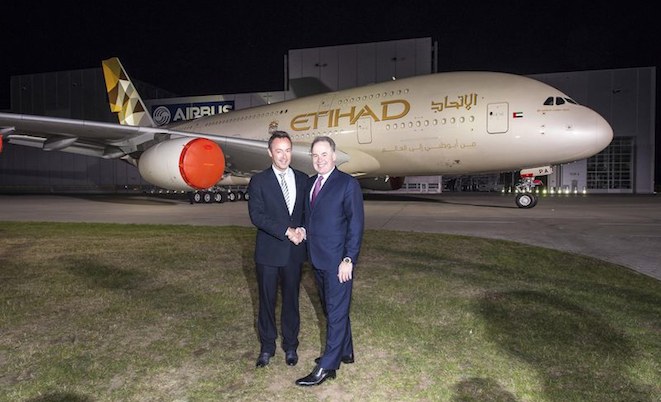
Etihad Airways’ Australian president and chief executive officer, James Hogan, was in his element at the rollout of his airline’s first Airbus A380 in Hamburg on Thursday night.
The rollout of the airline’s new flagship aircraft, and with it the public reveal of the airline’s smart new livery, is a significant milestone for the Abu Dhabi-based airline, and the man who leads it.
Hogan was in a relaxed and jovial mood during the rollout function, and deservedly so, given the significance of the rollout and the achievements it represents. Known as a sometimes demanding but fair leader, Hogan is a natural media performer, and the public face of Etihad clearly enjoyed Thursday’s event. During the rollout’s media conference, Airbus chief executive Fabrice Bregier was asked what sort of discount Etihad received with its A380 order. Bregier quipped “too much”, to which Hogan was quick to jokingly retort, “not enough!”
Clearly, given Eithad’s rise and rise, near enough has not been good enough for Hogan and his management team. With Hogan at its helm since September 2006, Etihad proudly lays claim to the crown of the “world’s fastest growing airline”. From modest beginnings, operating its first commercial service, to Beirut, in November 2003 with a leased Airbus A330, the airline has grown today to operate a fleet of 104 aircraft, and has no fewer than a further 200 on firm order. It operates to, or has announced plans to fly to, 110 destinations – including Sydney, Melbourne, Brisbane and Perth – and last year flew more than 11.5 million passengers. And then there is the growing number of airline equity investments, from Virgin Australia to Airberlin, which vastly increases the airline’s network reach and influence.
The airline’s rapid growth and its reputation for service delivery and innovation are both manifested in the A380, and both indicate Hogan’s growing influence as a leader in world aviation. Eithad has used the A380 as an opportunity to not only make over the airline’s corporate image, but to launch some true product innovation with exclusive ‘The Residence by Etihad’ and its first class apartment offerings.
The Residence has made the airline world sit up and take notice. To be fitted to the upper deck of the A380, and taking advantage of the awkward space in the aircraft’s crown immediately above and behind the flightdeck, The Residence will feature a living room, double bedroom and separate en suite bathroom for one or two passengers, served by a dedicated chef and butler service.
The Residence’s floor space is a luxurious 11.6 sqm, just less than half the size of an average 25 sqm hotel room, and, at $20,000 a ticket for a flight between Abu Dhabi and London, is clearly targeted at the Middle East’s high net worth individuals that might otherwise travel by private jet.
Hogan told media at the rollout that the residence product was selling well, that its launch in May had generated a huge amount of interest and publicity, and that the new product will be profitable for the airline.
Of course only two of the Eithad A380’s 498 passengers will enjoy the comfort and luxury of The Residence, but the product will likely have a significant halo effect for the airline as it continues to build on its reputation for service delivery.
In leading an organisation that is innovating on product, and innovating in building an airline network via a web of equity investments, it is a reasonable argument to mount that Melbourne-born Hogan, who began his airline career straight out of high school with Ansett in 1975, is the most influential Australian figure in world aviation today.
Undoubtedly the rise of Etihad and fellow gulf giants Emirates and Qatar has been enabled by supportive, even visionary government owners, favourable tax regimes and the natural advantages of geography, the kind of advantages that Australia’s own airlines lack. But it is one thing to enjoy natural advantages; it is another to take advantage of them.















